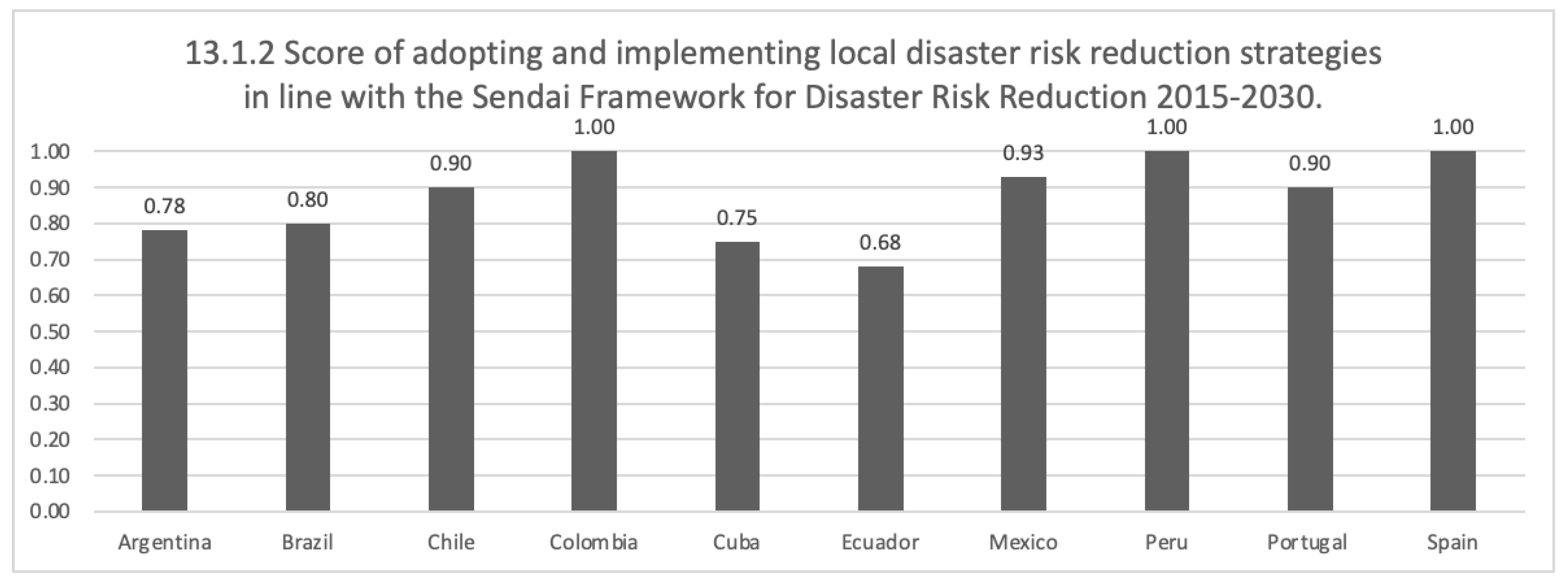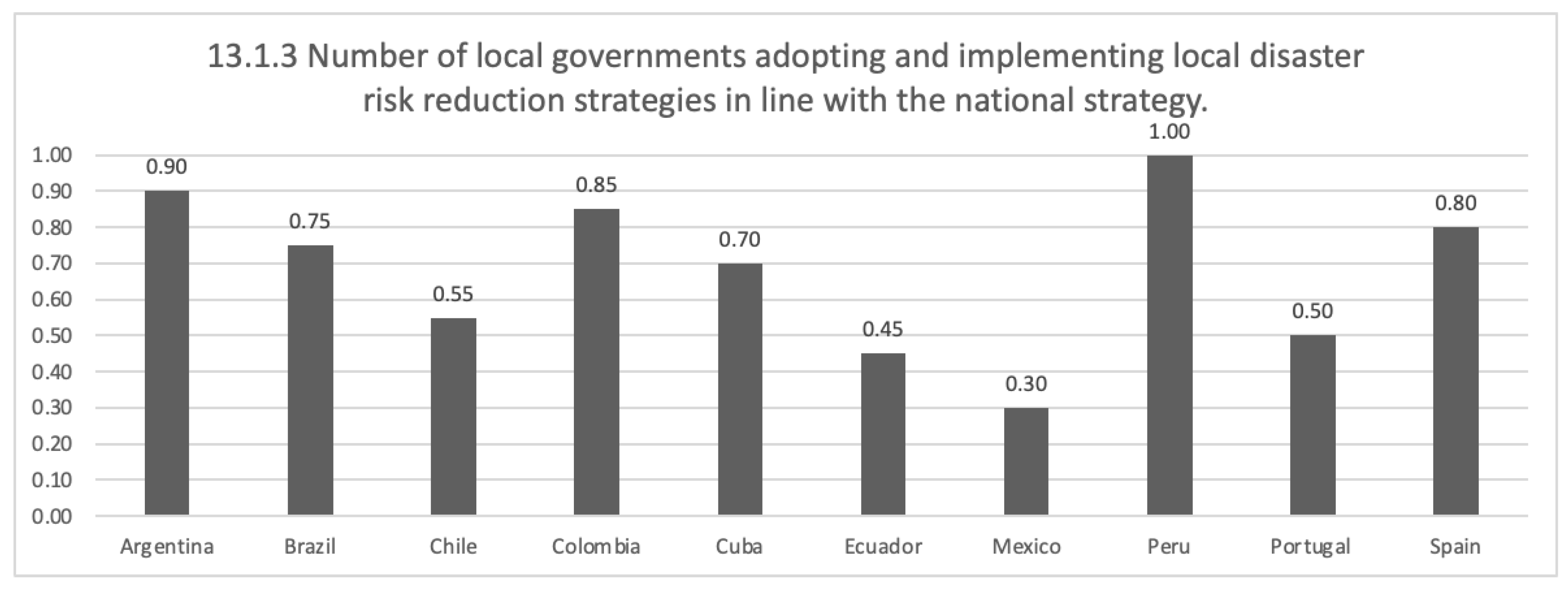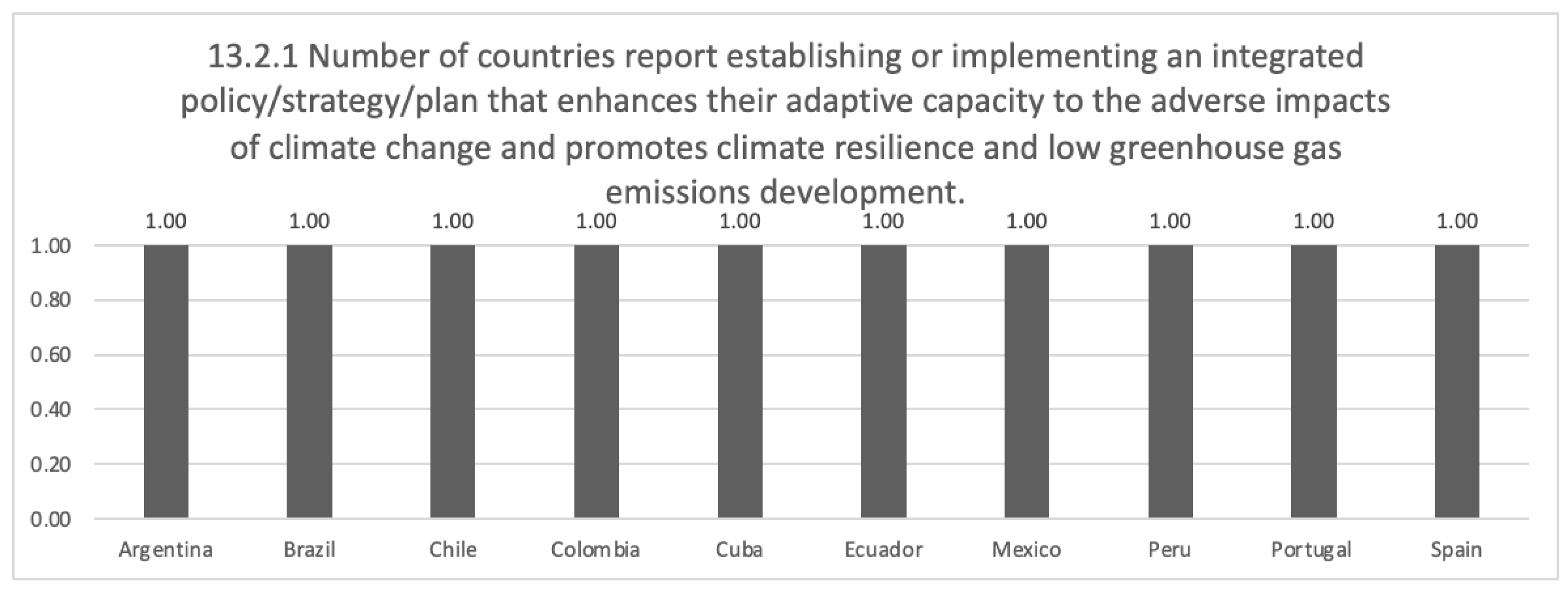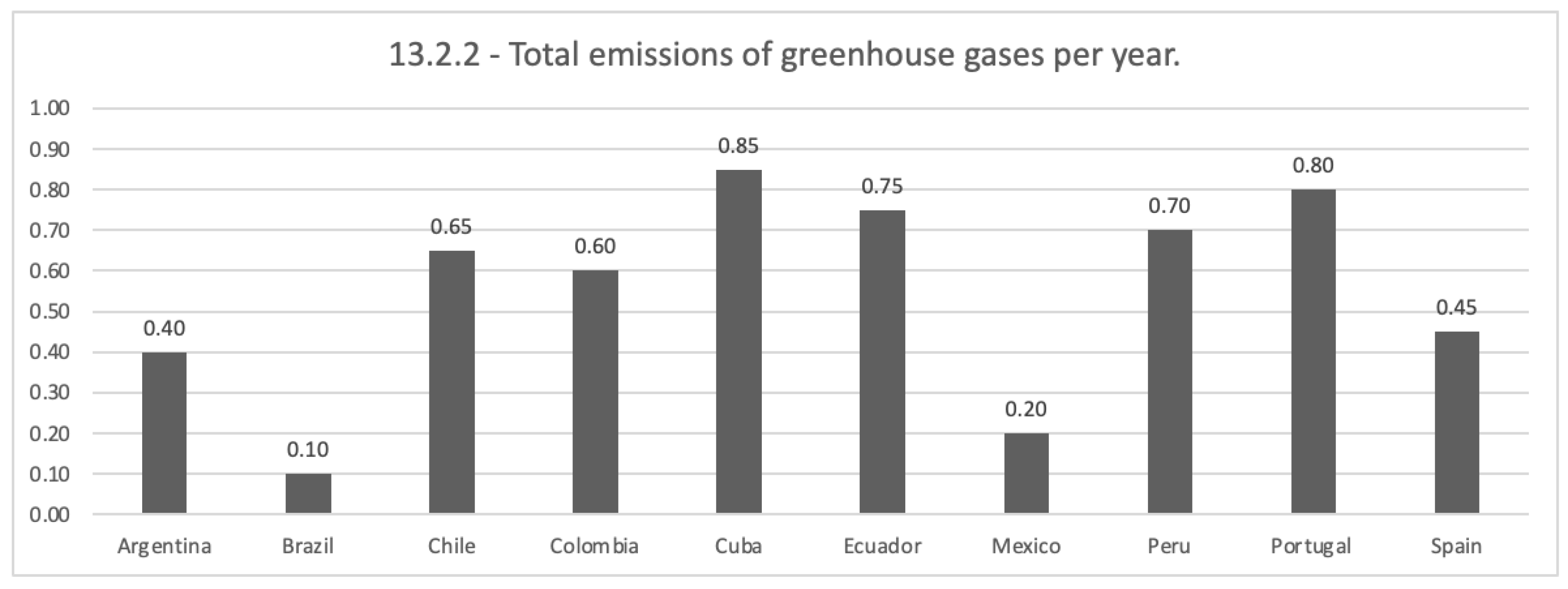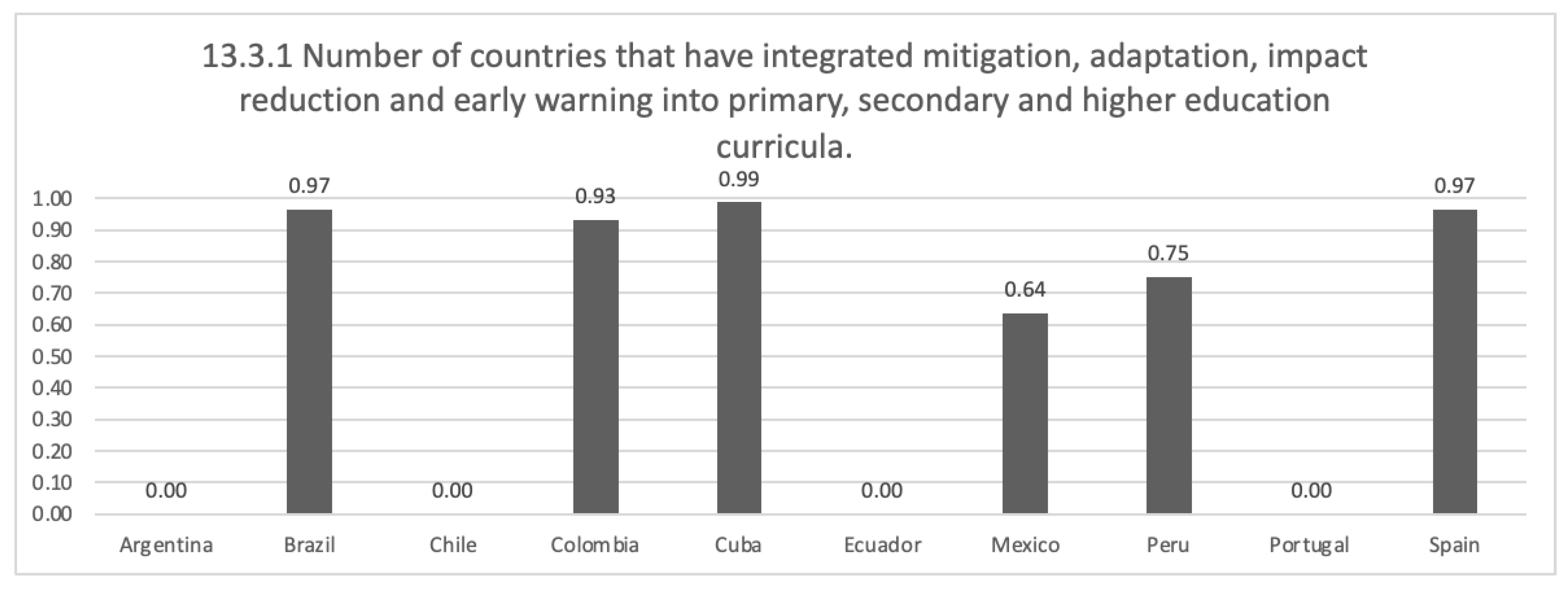Algorithm Applied to SDG13: A Case Study of Ibero-American Countries
Abstract
1. Introduction
2. Materials and Methods
2.1. Literature Review
2.1.1. Climate Change
2.1.2. OWA Operator
2.1.3. Climate Change and OWA Operator
2.2. Research Sample
2.3. Methodology
2.4. Variables and Measures
2.5. Collection of Official Data for SDG13
2.6. Application of the OWA Operator to SDG13
3. Results Applying OWA Operator to SDG13
4. Discussion of the Results
5. Conclusions
Author Contributions
Funding
Data Availability Statement
Acknowledgments
Conflicts of Interest
Appendix A
| Targets | SDG13 Indicators |
|---|---|
| 13.1 Strengthen resilience and adaptive capacity to climate-related hazards and natural disasters in all countries. | 13.1.1 Number of deaths, missing persons, and people directly affected by disasters per 100,000 people. a. Deaths—Exposure to forces of nature—Sex: Both—Age: All Ages (Rate). b. Number of deaths and missing persons attributed to disasters per 100,000 population. c. Internally displaced persons, new displacement associated with disasters. d. Number of directly affected persons attributed to disasters per 100,000 population. |
| 13.1.2 Score of adopting and implementing local disaster risk reduction strategies in line with the Sendai Framework for Disaster Risk Reduction 2015–2030. 13.1.3 Number of local governments adopting and implementing local disaster risk reduction strategies in line with the national strategy. | |
| 13.2 Integrate climate change measures into national policies, strategies, and planning. | 13.2.1 Number of countries report establishing or implementing an integrated policy/strategy/plan that enhances their adaptive capacity to the adverse impacts of climate change and promotes climate resilience and low greenhouse gas emissions development. 13.2.2—Total emissions of greenhouse gases per year. |
| 13.3 Improve education, awareness-raising, and human and institutional capacity on climate change mitigation, adaptation, impact reduction, and early warning. | 13.3.1 Number of countries that have integrated mitigation, adaptation, impact reduction, and early warning into primary, secondary, and higher education curricula. a. Extent to which global citizenship education and education for sustainable development are mainstreamed in curricula. b. Extent to which global citizenship education and education for sustainable development are mainstreamed in national education policies. c. Extent to which global citizenship education and education for sustainable development are mainstreamed in student assessment. d. Extent to which global citizenship education and education for sustainable development are mainstreamed in teacher education. |
| Adequacy Level | Evaluation |
|---|---|
| Null | 0 |
| Practically null | 0.1 |
| Almost weak | 0.2 |
| Very weak | 0.3 |
| Weak | 0.4 |
| Intermediate | 0.5 |
| Fair | 0.6 |
| Considerable | 0.7 |
| Strong | 0.8 |
| Very strong | 0.9 |
| Absolute | 1 |
| Indicator/ Countries | C1 | C2 | C3 | C4 | C5 | C6 | C7 | C8 | C9 | C10 |
|---|---|---|---|---|---|---|---|---|---|---|
| a. | 1 | 0.9 | 0.8 | 0.85 | 0.7 | 0.6 | 1 | 0.2 | 1 | 1 |
| b. | 0 | 0 | 1 | 0.9 | 0 | 0.3 | 0.95 | 0.85 | 0.2 | 0 |
| c. | 0.89 | 0.2 | 0.9 | 0.6 | 0.1 | 0.94 | 0.5 | 0.8 | 0.98 | 0.82 |
| d. | 0.9 | 0 | 1 | 0.65 | 0 | 1 | 0.85 | 0.3 | 0.1 | 0 |
| Total | 0.6975 | 0.275 | 0.925 | 0.75 | 0.2 | 0.71 | 0.825 | 0.5375 | 0.57 | 0.455 |
| Indicator/ Countries | C1 | C2 | C3 | C4 | C5 | C6 | C7 | C8 | C9 | C10 |
|---|---|---|---|---|---|---|---|---|---|---|
| a. | 0 | 0.94 | 0 | 0.88 | 1 | 0 | 0 | 0.81 | 0 | 0.91 |
| b. | 0 | 1 | 0 | 1 | 1 | 0 | 0.75 | 1 | 0 | 1 |
| c. | 0 | 0.92 | 0 | 1 | 1 | 0 | 1 | 1 | 0 | 1 |
| d. | 0 | 1 | 0 | 0.85 | 0.95 | 0 | 0.8 | 0.2 | 0 | 0.95 |
| Total | 0 | 0.965 | 0 | 0.9325 | 0.9875 | 0 | 0.6375 | 0.7525 | 0 | 0.965 |
References
- Haeffner, M.; Hames, F.; Barbour, M.M.; Reeves, J.M.; Platell, G.; Grover, S. Expanding collaborative autoethnography into the world of natural science for transdisciplinary teams. One Earth 2022, 5, 157–167. [Google Scholar] [CrossRef] [PubMed]
- Barcellos-Paula, L.; Gil-Lafuente, A.M.; Castro-Rezende, A. Socio-Economic and Health Management of Pandemics Based on Forgotten Effects Theory. Cybern. Syst. 2022, 54, 1–27. [Google Scholar] [CrossRef]
- Yazdani, M.; Mojtahedi, M.; Loosemore, M.; Sanderson, D. A modelling framework to design an evacuation support system for healthcare infrastructures in response to major flood events. Prog. Disaster Sci. 2022, 13, 100218. [Google Scholar] [CrossRef]
- Hu, Y. From global warming to complex physical systems: Reading of the 2021 Nobel Prize in Physics. Chin. Sci. Bull. 2022, 67, 548–556. [Google Scholar] [CrossRef]
- Bernet, M.; Torres Acosta, L. Rising sea level and increasing tropical cyclone frequency are threatening the population of San Andrés Island, Colombia, western Caribbean. BSGF Earth Sci. Bull. 2022, 193, 4. [Google Scholar] [CrossRef]
- Chaika, V.; Lisovyy, M.; Lakyda, M.; Konotop, Y.; Taran, N.; Miniailo, N.; Fedorchuk, S.; Klymenko, T.; Trembitska, O.; Chaika, S. Impact of climate change on biodiversity loss of entomofauna in agricultural landscapes of Ukraine. J. Cent. Eur. Agric. 2021, 22, 830–835. [Google Scholar] [CrossRef]
- Gosens, J.; Lu, Y.; He, G.; Bluemling, B.; Beckers, T.A.M. Sustainability effects of household-scale biogas in rural China. Energy Policy 2013, 54, 273–287. [Google Scholar] [CrossRef]
- Waheed, A.; Tariq, M. The Impact of Renewable Energy on Carbon Dioxide Emissions: An Empirical Analysis of Selected South Asian Countries. Ukr. J. Ecol. 2019, 9, 527–534. [Google Scholar] [CrossRef]
- Siegert, M.; Pearson, P. Reducing Uncertainty in 21st Century Sea-Level Predictions and Beyond. Front. Environ. Sci. 2021, 9, 751978. [Google Scholar] [CrossRef]
- Sánchez-Benítez, A.; Goessling, H.; Pithan, F.; Semmler, T.; Jung, T. The July 2019 European Heat Wave in a Warmer Climate: Storyline Scenarios with a Coupled Model Using Spectral Nudging. J. Clim. 2022, 35, 2373–2390. [Google Scholar] [CrossRef]
- Boccard, N. On the prevalence of forest fires in Spain. Nat. Hazards 2022, 114, 1043–1057. [Google Scholar] [CrossRef]
- Ahmad, D.; Afzal, M. Flood hazards and agricultural production risks management practices in flood-prone areas of Punjab, Pakistan. Environ. Sci. Pollut. Res. 2022, 29, 20768–20783. [Google Scholar] [CrossRef] [PubMed]
- Hochman, A.; Marra, F.; Messori, G.; Pinto, J.G.; Raveh-Rubin, S.; Yosef, Y.; Zittis, G. Extreme weather and societal impacts in the eastern Mediterranean. Earth Syst. Dyn. 2022, 13, 749–777. [Google Scholar] [CrossRef]
- Khraishah, H.; Alahmad, B.; Ostergard, R.L.; AlAshqar, A.; Albaghdadi, M.; Vellanki, N.; Chowdhury, M.M.; Al-Kindi, S.G.; Zanobetti, A.; Gasparrini, A.; et al. Climate change and cardiovascular disease: Implications for global health. Nat. Rev. Cardiol. 2022, 19, 798–812. [Google Scholar] [CrossRef] [PubMed]
- Monforte, P.; Ragusa, M.A. Temperature Trend Analysis and Investigation on a Case of Variability Climate. Mathematics 2022, 10, 2202. [Google Scholar] [CrossRef]
- Swarna, S.T.; Hossain, K. Climate change impact and adaptation for highway asphalt pavements: A literature review. Can. J. Civ. Eng. 2022, 49, 1109–1120. [Google Scholar] [CrossRef]
- Zhu, X.; Liu, T.; Xu, K.; Chen, C. The impact of high temperature and drought stress on the yield of major staple crops in northern China. J. Environ. Manag. 2022, 314, 115092. [Google Scholar] [CrossRef]
- United Nations. The Sustainable Development Goals Report 2022, 1st ed.; Jensen, L., Ed.; United Nations Publications: New York, NY, USA, 2022; ISBN 978-92-1-101448-8. [Google Scholar]
- Pörtner, H.-O.; Roberts, D.C.; Tignor, M.; Poloczanska, E.S.; Mintenbeck, K.; Alegría, A.; Craig, M.S.; Langsdorf, S.; Löschke, V.; Möller, V. (Eds.) Climate Change 2022: Impacts, Adaptation and Vulnerability Working Group II Contribution to the Sixth Assessment Report of the Intergovernmental Panel on Climate Change; Cambridge University Press: New York, NY, USA, 2022. [Google Scholar]
- Barcellos-Paula, L.; De la Vega, I.; Gil-Lafuente, A.M. The Quintuple Helix of Innovation Model and the SDGs: Latin-American Countries’ Case and Its Forgotten Effects. Mathematics 2021, 9, 416. [Google Scholar] [CrossRef]
- Hwang, H.; An, S.; Lee, E.; Han, S.; Lee, C. Cross-Societal Analysis of Climate Change Awareness and Its Relation to SDG 13: A Knowledge Synthesis from Text Mining. Sustainability 2021, 13, 5596. [Google Scholar] [CrossRef]
- Mitchell, D.; Allen, M.R.; Hall, J.W.; Muller, B.; Rajamani, L.; Le Quéré, C. The myriad challenges of the Paris Agreement. Philos. Trans. R. Soc. A Math. Phys. Eng. Sci. 2018, 376, 20180066. [Google Scholar] [CrossRef]
- Pradhan, P.; Costa, L.; Rybski, D.; Lucht, W.; Kropp, J.P. A Systematic Study of Sustainable Development Goal (SDG) Interactions. Earth’s Futur. 2017, 5, 1169–1179. [Google Scholar] [CrossRef]
- Nilsson, M.; Griggs, D.; Visbeck, M. Policy: Map the interactions between Sustainable Development Goals. Nature 2016, 534, 320–322. [Google Scholar] [CrossRef] [PubMed]
- Steffen, W.; Richardson, K.; Rockström, J.; Cornell, S.E.; Fetzer, I.; Bennett, E.M.; Biggs, R.; Carpenter, S.R.; de Vries, W.; de Wit, C.A.; et al. Planetary boundaries: Guiding human development on a changing planet. Science 2015, 347, 1259855. [Google Scholar] [CrossRef]
- Zadeh, L.A. Fuzzy sets. Inf. Control. 1965, 8, 338–353. [Google Scholar] [CrossRef]
- Yager, R.R. On ordered weighted averaging aggregation operators in multicriteria decisionmaking. IEEE Trans. Syst. Man. Cybern. 1988, 18, 183–190. [Google Scholar] [CrossRef]
- Barcellos-Paula, L.; de La Vega, I.; Gil-Lafuente, A.M. Bibliometric review of research on decision models in uncertainty, 1990–2020. Int. J. Intell. Syst. 2022, 37, 7300–7333. [Google Scholar] [CrossRef]
- Nădăban, S. Fuzzy Logic and Soft Computing—Dedicated to the Centenary of the Birth of Lotfi A. Zadeh (1921–2017). Mathematics 2022, 10, 3216. [Google Scholar] [CrossRef]
- Wilberforce, T.; El-Hassan, Z.; Khatib, F.N.; Al Makky, A.; Baroutaji, A.; Carton, J.G.; Olabi, A.G. Developments of electric cars and fuel cell hydrogen electric cars. Int. J. Hydrog. Energy 2017, 42, 25695–25734. [Google Scholar] [CrossRef]
- Melin, P.; Monica, J.C.; Sanchez, D.; Castillo, O. Multiple Ensemble Neural Network Models with Fuzzy Response Aggregation for Predicting COVID-19 Time Series: The Case of Mexico. Healthcare 2020, 8, 181. [Google Scholar] [CrossRef]
- Barcellos-Paula, L.; Agüero-Olivos, C. The strengthening of corporate governance based on applied fuzzy logic. Corp. Soc. Responsib. Environ. Manag. 2022, 29, 1736–1746. [Google Scholar] [CrossRef]
- Merigó, J.M.; Gil-Lafuente, A.M. Induced 2-tuple linguistic generalized aggregation operators and their application in decision-making. Inf. Sci. 2013, 236, 1–16. [Google Scholar] [CrossRef]
- Barcellos de Paula, L.; Marins, F.A.S. Algorithms applied in decision-making for sustainable transport. J. Clean. Prod. 2018, 176, 1133–1143. [Google Scholar] [CrossRef]
- Vizuete-Luciano, E.; Boria-Reverter, S.; Merigó-Lindahl, J.M.; Gil-Lafuente, A.M.; Solé-Moro, M.L. Fuzzy Branch-and-Bound Algorithm with OWA Operators in the Case of Consumer Decision Making. Mathematics 2021, 9, 3045. [Google Scholar] [CrossRef]
- Will, M.; Bertrand, J.; Fransoo, J.C. Operations management research methodologies using quantitative modeling. Int. J. Oper. Prod. Manag. 2002, 22, 241–264. [Google Scholar] [CrossRef]
- Harper, A.; Mustafee, N.; Yearworth, M. Facets of trust in simulation studies. Eur. J. Oper. Res. 2021, 289, 197–213. [Google Scholar] [CrossRef]
- Yin, R. Case Study Research, Design Methods, 5th ed.; SAGE Publications Ltd.: Thousand Oaks, CA, USA, 2014; ISBN 978-1452242569. [Google Scholar]
- Hersbach, H.; Bell, B.; Berrisford, P.; Hirahara, S.; Horányi, A.; Muñoz-Sabater, J.; Nicolas, J.; Peubey, C.; Radu, R.; Schepers, D.; et al. The ERA5 global reanalysis. Q. J. R. Meteorol. Soc. 2020, 146, 1999–2049. [Google Scholar] [CrossRef]
- Wang, H.; Naghavi, M.; Allen, C.; Barber, R.M.; Bhutta, Z.A.; Carter, A.; Casey, D.C.; Charlson, F.J.; Chen, A.Z.; Coates, M.M.; et al. Global, regional, and national life expectancy, all-cause mortality, and cause-specific mortality for 249 causes of death, 1980–2015: A systematic analysis for the Global Burden of Disease Study 2015. Lancet 2016, 388, 1459–1544. [Google Scholar] [CrossRef]
- Liu, H.; Rodríguez, R.M. A fuzzy envelope for hesitant fuzzy linguistic term set and its application to multicriteria decision making. Inf. Sci. 2014, 258, 220–238. [Google Scholar] [CrossRef]
- Zeng, S.; Chen, J.; Li, X. A Hybrid Method for Pythagorean Fuzzy Multiple-Criteria Decision Making. Int. J. Inf. Technol. Decis. Mak. 2016, 15, 403–422. [Google Scholar] [CrossRef]
- Amir Rahmani, M.; Zarghami, M. A new approach to combine climate change projections by ordered weighting averaging operator; applications to northwestern provinces of Iran. Glob. Planet Change 2013, 102, 41–50. [Google Scholar] [CrossRef]
- Llopis-Albert, C.; Merigó, J.M.; Xu, Y.; Liao, H. Improving Regional Climate Projections by Prioritized Aggregation via Ordered Weighted Averaging Operators. Environ. Eng. Sci. 2017, 34, 880–886. [Google Scholar] [CrossRef]
- Chen, Y.; Li, M.; Su, K.; Li, X. Spatial-Temporal Characteristics of the Driving Factors of Agricultural Carbon Emissions: Empirical Evidence from Fujian, China. Energies 2019, 12, 3102. [Google Scholar] [CrossRef]
- SIEMCI Red Temática Número 522RT0130 en Programa Iberoamericano de Ciencia y Tecnología para el Desarrollo (CYTED) 2022–2025. Available online: https://siemci.org/proyecto/ (accessed on 18 December 2022).
- Barcellos de Paula, L. Modelos de Gestión Aplicados a la Sostenibilidad Empresarial. Ph.D. Thesis, Universitat de Barcelona, Barcelona, Spain, 2011. [Google Scholar]
- Kaufmann, A.; Gil Aluja, J. Introducción de la Teoría de los Subconjuntos Borrosos a la Gestión de las Empresas; Milladoiro: Santiago de Compostela, Spain, 1986; ISBN 9788439876304. [Google Scholar]
- Ritchie, H.; Roser, M.; Mispy, O.-O. Measuring Progress towards the Sustainable Development Goals. Available online: https://sdg-tracker.org (accessed on 29 September 2022).
- United Nations UN Office for Disaster Risk Reduction. Available online: https://www.undrr.org (accessed on 28 September 2022).
- Ritchie, H.; Roser, M.; Rosado, P. CO2 and Greenhouse Gas Emissions. Available online: https://ourworldindata.org/co2-and-other-greenhouse-gas-emissions (accessed on 29 September 2022).
- Haer, T.; Botzen, W.J.W.; Zavala-Hidalgo, J.; Cusell, C.; Ward, P.J. Economic evaluation of climate risk adaptation strategies: Cost-benefit analysis of flood protection in Tabasco, Mexico. Atmósfera 2017, 30, 101–120. [Google Scholar] [CrossRef]
- Collier, P.; Conway, G.; Venables, T. Climate change and Africa. Oxf. Rev. Econ. Policy 2008, 24, 337–353. [Google Scholar] [CrossRef]
- Lei, Y.; Finlayson, C.; Thwaites, R.; Shi, G.; Cui, L. Using Government Resettlement Projects as a Sustainable Adaptation Strategy for Climate Change. Sustainability 2017, 9, 1373. [Google Scholar] [CrossRef]
- Maini, R.; Clarke, L.; Blanchard, K.; Murray, V. The Sendai Framework for Disaster Risk Reduction and Its Indicators—Where Does Health Fit in? Int. J. Disaster Risk Sci. 2017, 8, 150–155. [Google Scholar] [CrossRef]
- Kelly, S.; Pollitt, M. An assessment of the present and future opportunities for combined heat and power with district heating (CHP-DH) in the United Kingdom. Energy Policy 2010, 38, 6936–6945. [Google Scholar] [CrossRef]
- Zajac, M.; Skocek, J.; Ben Haha, M.; Deja, J. CO2 Mineralization Methods in Cement and Concrete Industry. Energies 2022, 15, 3597. [Google Scholar] [CrossRef]
- Tormey, D.; Dongying, W.; Aixia, F. Geoheritage Education as a Gateway to Developing a Conservation Ethic in High School Students from China and the USA. Geoheritage 2022, 14, 79. [Google Scholar] [CrossRef]
- Fady, B.; Geburek, T.; Scotti, I. Science needs management data for a better prediction of climate change effects on socio-ecosystems. Ann. For. Sci. 2019, 76, 12. [Google Scholar] [CrossRef]
- Wang, L.; Garg, H.; Li, N. Pythagorean fuzzy interactive Hamacher power aggregation operators for assessment of express service quality with entropy weight. Soft Comput. 2021, 25, 973–993. [Google Scholar] [CrossRef]
- United Nations. Goal 13: Take Urgent Action to Combat Climate Change and Its Impacts. Available online: https://www.un.org/sustainabledevelopment/climate-change/ (accessed on 11 October 2022).
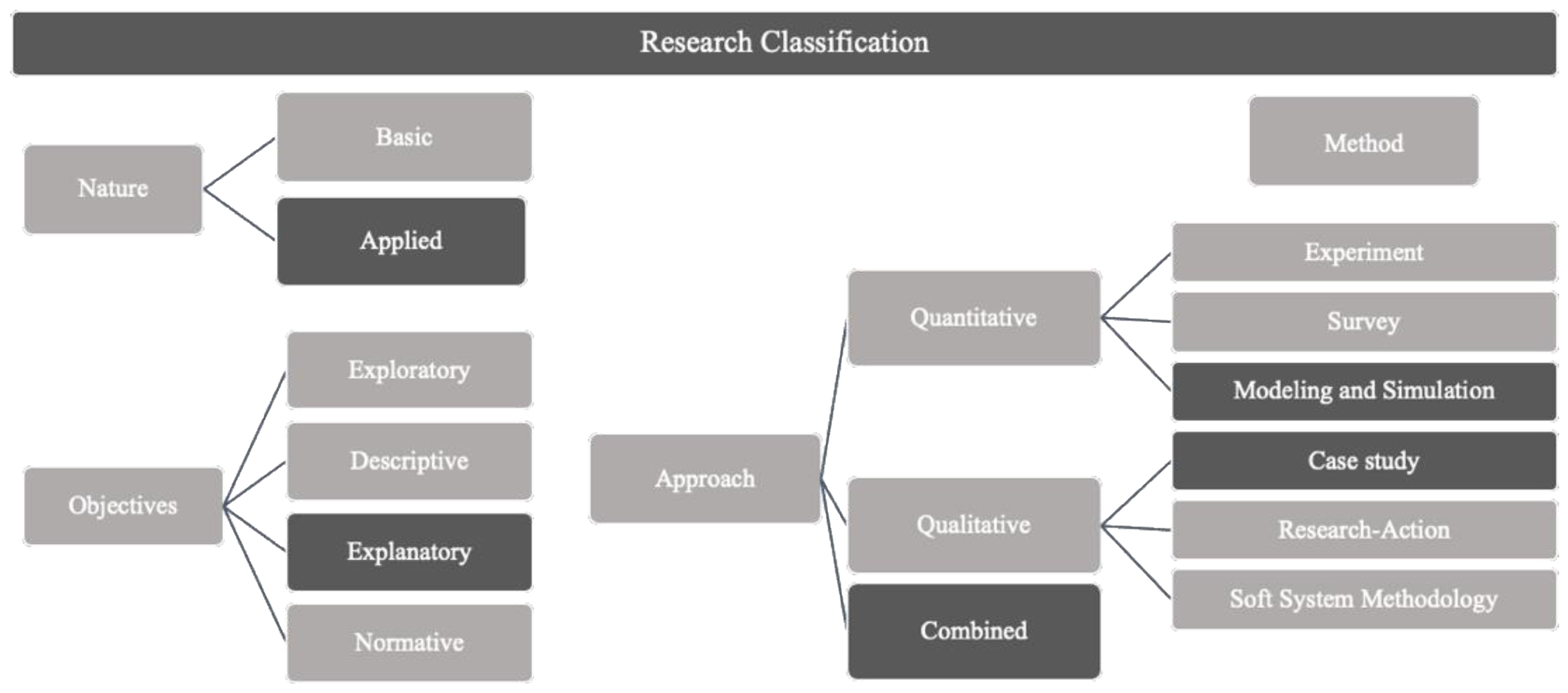
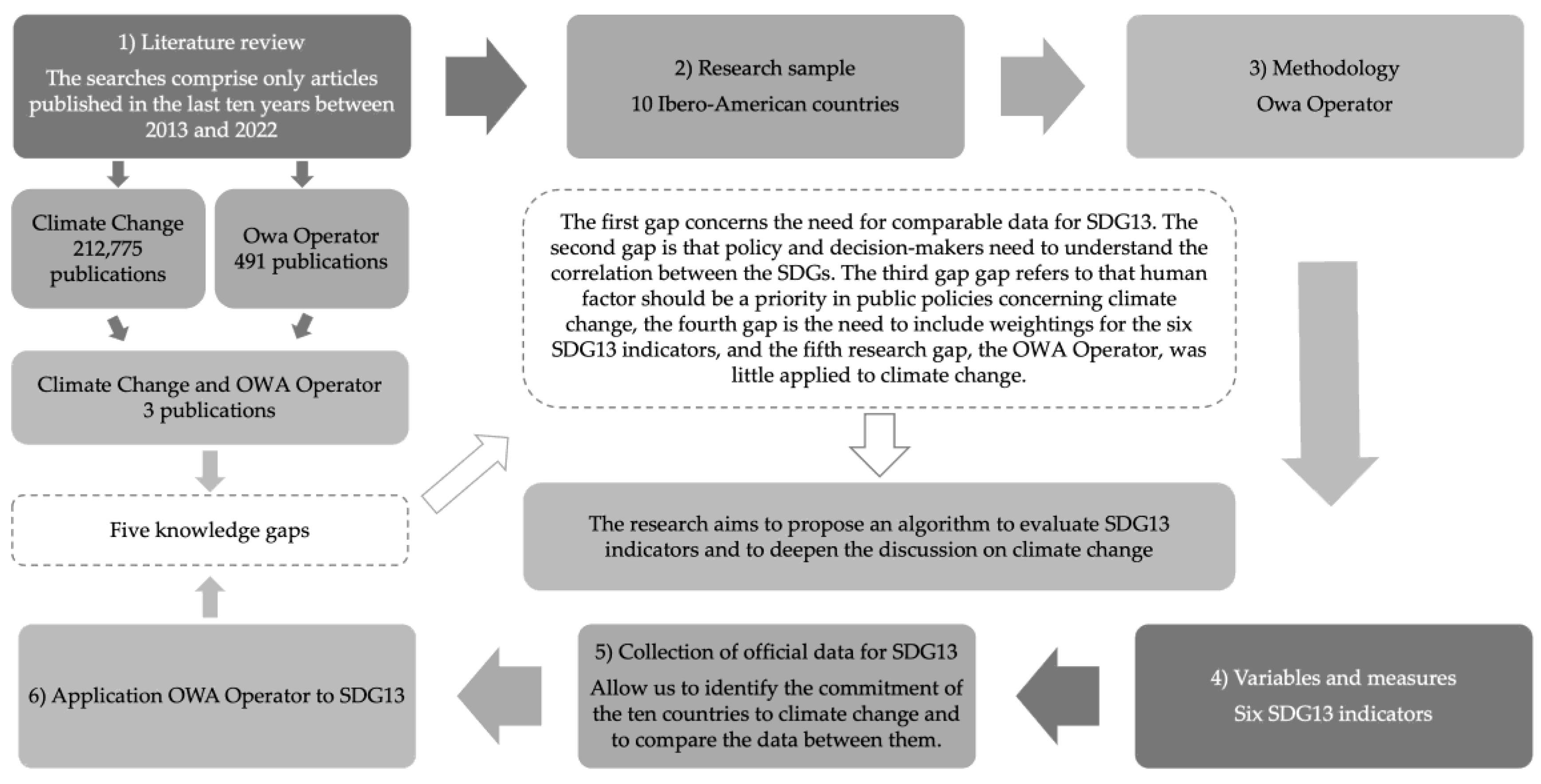
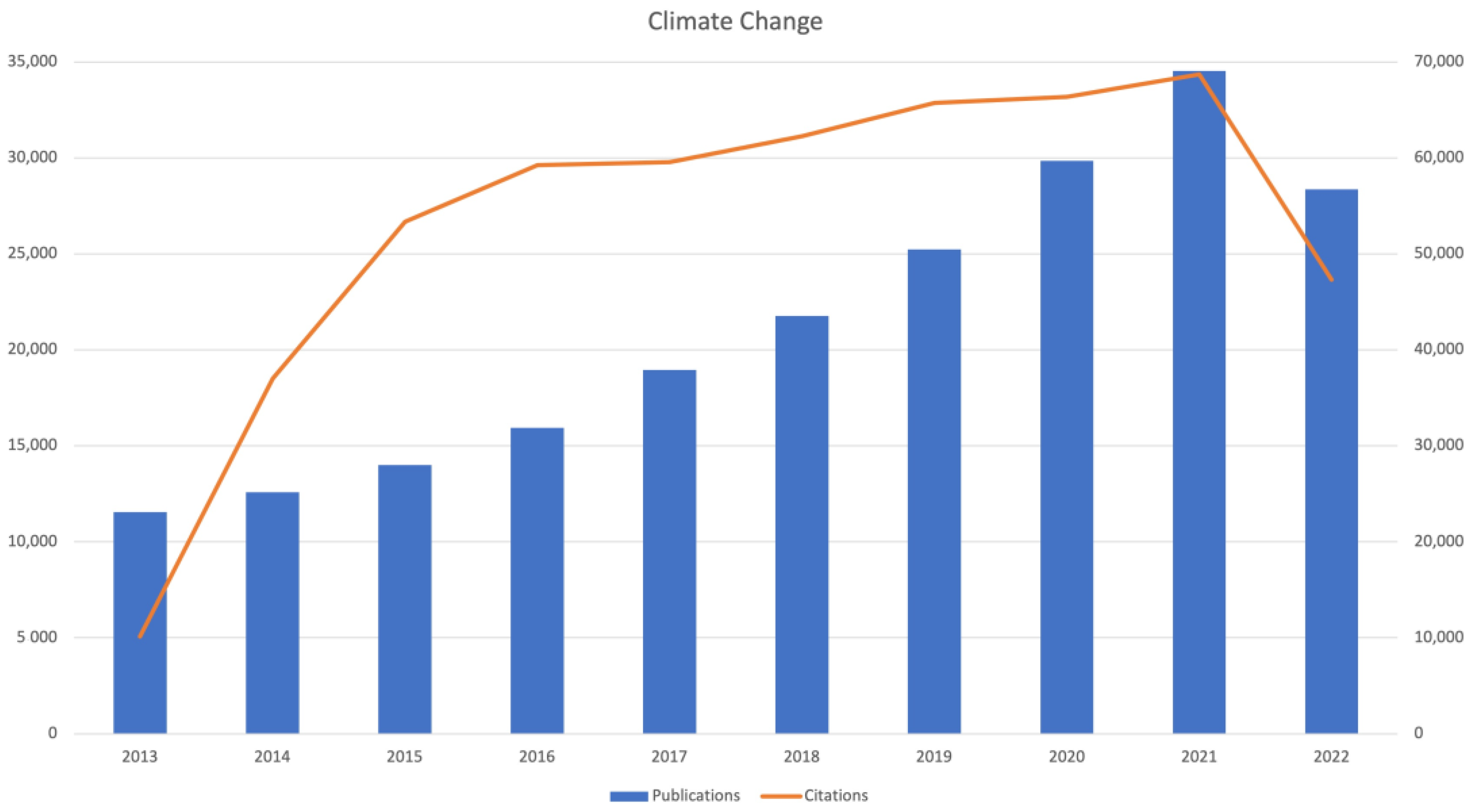

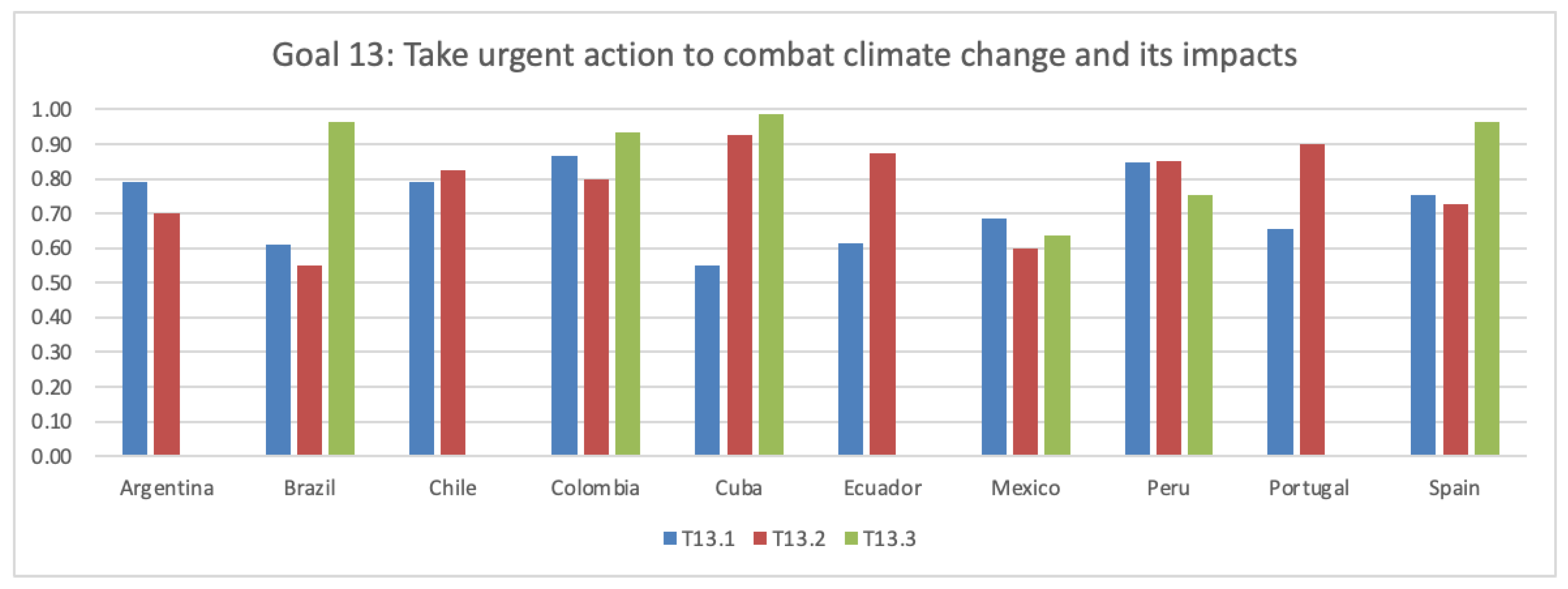
| Weights | W1 | W2 | W3 | W4 | W5 | W6 |
|---|---|---|---|---|---|---|
| W= | 0.05 | 0.10 | 0.10 | 0.25 | 0.45 | 0.05 |
| SDG13 Indicators | 13.1.1 | 13.1.2 | 13.1.3 | 13.2.1 | 13.2.2 | 13.3.1 |
| SDG13 Indicators | |||||||
|---|---|---|---|---|---|---|---|
| Code | Countries | 13.1.1 | 13.1.2 | 13.1.3 | 13.2.1 | 13.2.2 | 13.3.1 |
| C1 | Argentina | 0.70 | 0.78 | 0.90 | 1.00 | 0.40 | 0.00 |
| C2 | Brazil | 0.28 | 0.80 | 0.75 | 1.00 | 0.10 | 0.97 |
| C3 | Chile | 0.93 | 0.90 | 0.55 | 1.00 | 0.65 | 0.00 |
| C4 | Colombia | 0.75 | 1.00 | 0.85 | 1.00 | 0.60 | 0.93 |
| C5 | Cuba | 0.20 | 0.75 | 0.70 | 1.00 | 0.85 | 0.99 |
| C6 | Ecuador | 0.71 | 0.68 | 0.45 | 1.00 | 0.75 | 0.00 |
| C7 | Mexico | 0.83 | 0.93 | 0.30 | 1.00 | 0.20 | 0.64 |
| C8 | Peru | 0.54 | 1.00 | 1.00 | 1.00 | 0.70 | 0.75 |
| C9 | Portugal | 0.57 | 0.90 | 0.50 | 1.00 | 0.80 | 0.00 |
| C10 | Spain | 0.46 | 1.00 | 0.80 | 1.00 | 0.45 | 0.97 |
| Code | Countries | OWA | Position |
|---|---|---|---|
| C1 | Argentina | 0.5730 | 7° |
| C2 | Brazil | 0.5455 | 9° |
| C3 | Chile | 0.6430 | 5° |
| C4 | Colombia | 0.8230 | 1° |
| C5 | Cuba | 0.7465 | 3° |
| C6 | Ecuador | 0.5685 | 8° |
| C7 | Mexico | 0.5310 | 10° |
| C8 | Peru | 0.7795 | 2° |
| C9 | Portugal | 0.5875 | 6° |
| C10 | Spain | 0.6765 | 4° |
| Sets | Scale | Adequacy Level | Countries |
|---|---|---|---|
| S1 | [0.90; 0.99] | Absolute | |
| S2 | [0.90; 0.99] | Very strong | |
| S3 | [0.80; 0.89] | Strong | C4 |
| S4 | [0.70; 0.79] | Considerable | C8 and C5 |
| S5 | [0.60; 0.69] | Fair | C10 and C3 |
| S6 | [0.50; 0.59] | Intermediate | C9, C1, C6, C2 and C7 |
| S7 | [0.40; 0.49] | Weak | |
| S8 | [0.30; 0.39] | Very weak | |
| S9 | [0.20; 0.29] | Slightly weak | |
| S10 | [0.10; 0.19] | Practically null | |
| S11 | [0.00; 0.09] | Null |
Disclaimer/Publisher’s Note: The statements, opinions and data contained in all publications are solely those of the individual author(s) and contributor(s) and not of MDPI and/or the editor(s). MDPI and/or the editor(s) disclaim responsibility for any injury to people or property resulting from any ideas, methods, instructions or products referred to in the content. |
© 2023 by the authors. Licensee MDPI, Basel, Switzerland. This article is an open access article distributed under the terms and conditions of the Creative Commons Attribution (CC BY) license (https://creativecommons.org/licenses/by/4.0/).
Share and Cite
Barcellos-Paula, L.; Gil-Lafuente, A.M.; Castro-Rezende, A. Algorithm Applied to SDG13: A Case Study of Ibero-American Countries. Mathematics 2023, 11, 313. https://doi.org/10.3390/math11020313
Barcellos-Paula L, Gil-Lafuente AM, Castro-Rezende A. Algorithm Applied to SDG13: A Case Study of Ibero-American Countries. Mathematics. 2023; 11(2):313. https://doi.org/10.3390/math11020313
Chicago/Turabian StyleBarcellos-Paula, Luciano, Anna María Gil-Lafuente, and Aline Castro-Rezende. 2023. "Algorithm Applied to SDG13: A Case Study of Ibero-American Countries" Mathematics 11, no. 2: 313. https://doi.org/10.3390/math11020313
APA StyleBarcellos-Paula, L., Gil-Lafuente, A. M., & Castro-Rezende, A. (2023). Algorithm Applied to SDG13: A Case Study of Ibero-American Countries. Mathematics, 11(2), 313. https://doi.org/10.3390/math11020313








